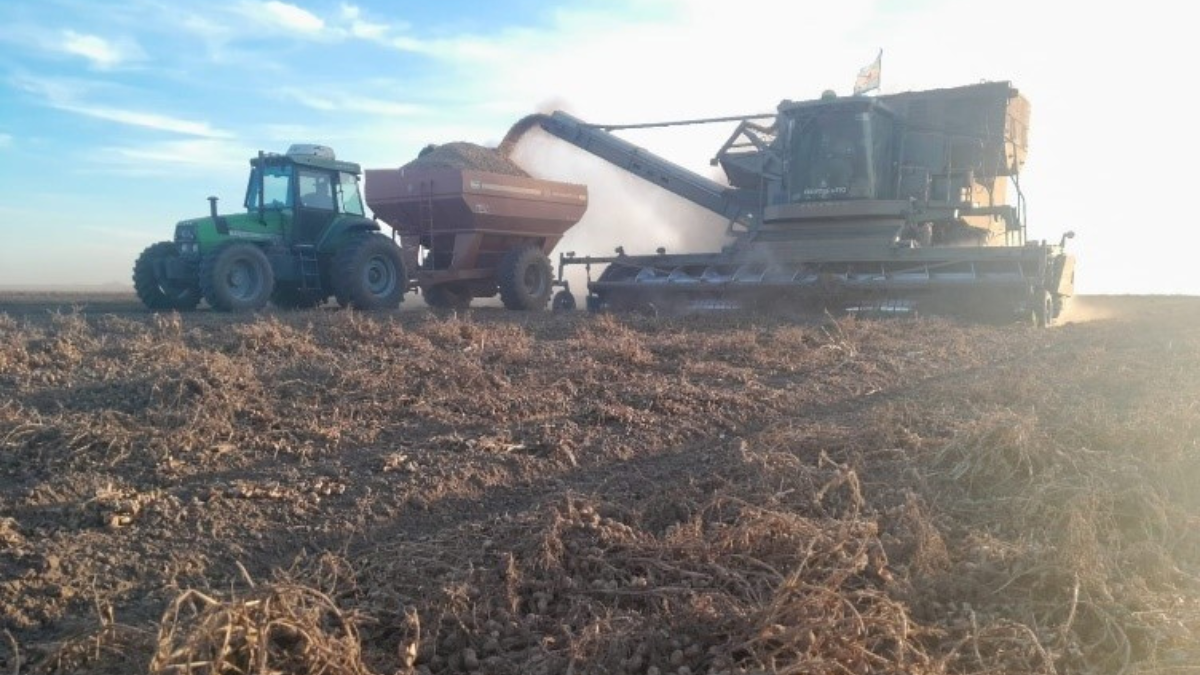
7th Peanut Crop Report as per June 1st
Overview of the 7th Crop Report
The current situation of peanuts is very varied according to the geographical area in which they are found. The general state of the peanut crop is in a range from fair to good for most of the planted area. The peanut crop continues to show the greatest decreases in production compared to the previous crop, due to the drought that occurred throughout the spring-summer season.
As of the date of preparation of this report, the progress of digging is around 96% of the total planted area.

With a harvest advance of 38%, a reduction of 30-32% inshell yield is estimated compared to the previous year, positioning itself at an average value of 2-2.2 Tn/ha for the peanut area, which includes to the provinces of: Córdoba (90%), La Pampa (7%) and Buenos Aires (3%).

Regarding the production in the farms, the expectation of obtaining high yields gradually decreased. As the drought suffered in the months of January, February and March deepened, many pods have aborted the grain or have not formed it at all.
Regardless of the volume of losses that occurred, the greatest concern today is for the quality of the peanuts, either due to the greater number of foreign bodies received with the farmerstock (the producer tries not to lose grains by adjusting the combine to “load” all), as well as physical damage.


Regarding the sizes of peanuts received, up to now, we have detected a smaller quantity of large grains (30/38-38/42), taking into account the dry conditions and extreme heat that they experienced.
Within the most affected areas in terms of quality and low yields, we find the province of Córdoba, with the Juárez Celman department being the most compromised, followed by the departments of Río Cuarto and Tercero Arriba. The Northern area was also hit hard by the drought, so yields will drop below average.
As a result of the considerations indicated above, and according to the survey carried out batch by batch, today we estimate an average yield of 2-2.2 Tn/ha (dry and clean shelled peanut base).
Compared to the state of the peanut crop in the last report, the situation has deteriorated.
The current condition of the crop, according to our survey, is the following:

The rains received in the week of May 21 to 27, had generated a suspension in all harvest activities in the different areas. Entering the last week of May, the weather conditions improved and it was possible to return to harvesting activities in all areas.
Our reference map of peanut production areas
The main peanut areas in Argentina include the provinces of Córdoba, La Pampa, San Luis and Buenos Aires.

Projected field tasks
As previously mentioned, today, the digging tasks are 96% complete with respect to the total hectares planted. In general terms, this work was slower than other years since the peanuts were immature (less than 50% ripe), so it was decided to wait as many days as possible to try to reach the desired percentage of ripeness. This immaturity is caused to a large extent by the drought experienced throughout the crop cycle. In turn, aggravated by the frost that occurred on February 18.
Regarding harvesting activities, we estimate that progress is 32%, having resumed harvesting tasks.
During the first and third week of May, a storm of winds broke out with gusts of more than 80 km/h that scattered the rows of peanut production, leaving it piled up on the fences and the scattered plants in the lot that had to be accommodated. in parts by hand. This makes harvesting difficult as the machines step on the rows that are out of position. The losses caused were important, difficult to calculate, because the pods are detached from the plants. The areas affected by this storm were: the southern area (Huinca Renancó, Ranqueles, Pincen, Vicuña Mackenna) and the northern area (Lozada and Río Segundo).




Final Appreciations
As we focus on the digging and harvesting tasks, which are the last critical steps in the peanut cycle, it is essential that the weather conditions are sunny and without rain, since in this way a good progress is being ensured and no hiccups.
Peanut cultivation continues to be a regular project in terms of yields, although their situation can be more accurately described as heterogeneous, since in the same area we can find peanut lots with high and low yields per hectare. This great heterogeneity is caused by the climatic variability that we experienced during the development of the crop.
After what has been described above, we can estimate that the average yields will be between 2-2.2 Tn/ha, far behind the last (2021-2022) and previous harvest (2020-2021).
We must bear in mind that the winds that occurred a few days ago have caused irreparable losses that we still cannot quantify what the real loss will be in kg/ha, since the pods have been detached from the plants and are scattered on the ground and impossible to be harvested.
There is no doubt that this is a very difficult year for the Argentine peanut sector; Producers in many areas will have yields well below their indifference yield, which is why they find it difficult to face a new peanut campaign.
The next few weeks will be key to defining the final results of the 2023 harvest in Argentina, both in terms of yields and quality. The crop is in the “final stretch”, so it will be essential to pay special attention to the final tasks (harvest) that the crop demands.
Today we are in a scenario of great uncertainty that complicates business decision-making. Only the constant progress of the harvest will reveal what the final results will be, and consequently what Argentina’s offer will be for the different markets. From now on, with what has happened up to the present, we know that exports will decrease significantly compared to last year; the hard thing to know is how much less we will have to offer.
It is essential that the good weather conditions continue in the coming weeks, so as not to incur further losses in the field and to be able to receive shelled peanuts at the storage plants with acceptable humidity levels.
Images of the crop in the different productive zones;








